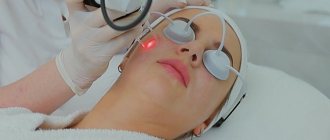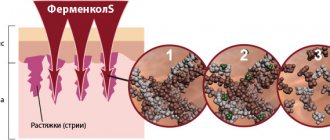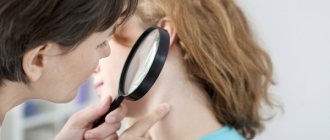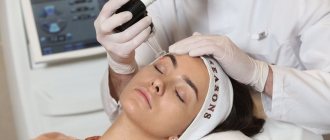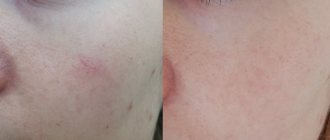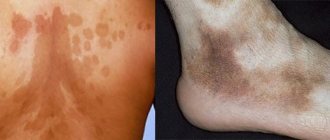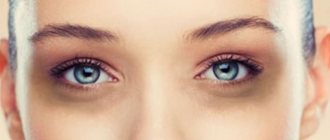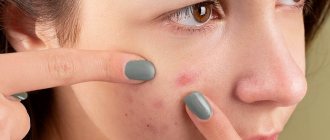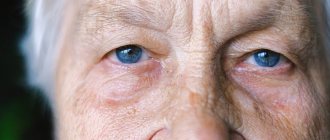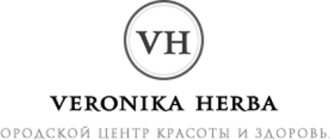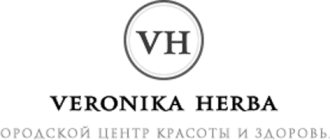Laser back resurfacing is a procedure for correcting post-acne scars and skin pigmentation, as well as various other atrophic changes in skin quality. The appearance of post-acne scars or pigmentation on the back can be caused by a number of factors, including hormonal imbalance. Both women and men are susceptible to this problem.
The most effective method for correcting and eliminating post-acne scars on the back is laser resurfacing. Its effectiveness directly depends on several factors:
- Equipment quality
- Doctor's qualifications
- Compliance with power regulations in certain indications
- Compliance with post-procedural regime
What is post-acne
Post-acne is a condition of the skin that occurs after severe acne. Spots and deep scars form on the face. A cosmetic defect seriously spoils a person’s life, forcing him to be embarrassed about his appearance and constantly experience severe discomfort in different environments.
Reasons for the appearance of post-acne:
- inadequate treatment of acne and non-compliance with hygiene standards;
- independent attempts to remove the rash during illness (squeezing out lesions);
- a severe form of acne, in which inflammatory lesions penetrate deep into the skin.
People who are faced with such a problem as post-acne know that it is almost impossible to free the skin from unpleasant scars, since the defects have been formed over a long time.
Reasons for the appearance of post-acne
Most often, post-acne acne occurs when:
- long-term inflammatory process (more than a year);
- severe acne;
- the presence of genetic characteristics;
- improper treatment of acne;
- frequent squeezing of blackheads.
Scars form in three stages:
- inflammatory phase: inflammation affects the synthesis of melanin, which then leads to the appearance of dark or light acne spots;
- formation of granulation tissue: fibroblasts synthesize collagen, which leads to restoration of the integrity of the skin;
- restoration of the cellular framework of the skin.
The essence of post-acne laser treatment
The treatment process involves removing scars and other defects using a laser. During delicate grinding, the top layer of the epidermis is removed. The skin is cleansed of old surface cells, the effect starts the process of regeneration of the skin and renewal of its cellular composition.
azer (with a wavelength of 10600 nm) has a gentle effect on the skin. The energy is emitted through the scanning screen in the form of many tiny microbeams. The doctor adjusts the diameter and distance between the beams taking into account the individual characteristics of the patient.
Laser resurfacing result:
- cell regeneration and elimination of scar tissue;
- cleansing and smoothing the skin surface;
- structural rejuvenation of the epidermis;
- stimulation of elastin and collagen production.
Italian lasers rejuvenate facial skin, restore it to its former youth and freshness, eliminate the effects of acne and give a person the opportunity to feel confident and at ease again.
DOT and DOT 2 resurfacing relieves the patient of all the unpleasant marks left behind by acne - scars, red and bluish spots, deep scars. The treatment procedure is under 100% control of a specialist; the doctor himself sets and regulates the degree of exposure to micro-rays.
Contraindications to procedures
- acne in the acute stage;
- presence of other damage to the skin;
- infectious, viral diseases;
- herpes;
- heat;
- exacerbation of chronic diseases;
- high sensitivity to light;
- epilepsy;
- any cancer;
- pregnancy.
The procedure is not performed during menstruation and breastfeeding.
| Fractional treatment of scar tissue in aesthetic gynecology up to 10 cm² Fotona | 5 000,00 | View all services |
If there are contraindications to laser resurfacing, you will be offered another service or a way to minimize the appearance of post-acne.
Benefits of laser treatment for post-acne
This is one of the most effective technologies that eliminates the consequences of the disease. Light rays leave no chance for defects, launching powerful skin rejuvenation processes:
- Photomodification – fights scar tissue.
- Normalizes blood circulation - helps remove stagnant spots.
- Photocoagulation of dilated vessels.
- Destruction of melanin - getting rid of dark spotty formations.
- Improving metabolic processes in the dermis - this increases tone and reduces pore size.
Polishing using the latest Italian equipment eliminates skin defects caused by independent, unqualified treatment of the rash.
The technology used in El. En” is safe and painless. A full course of procedures leads to the desired result - the elimination of existing facial damage. A gentle effect helps improve the overall condition of the dermis and renew cells.
The technique is recommended for everyone who is interested in quickly and effectively getting rid of the consequences of acne.
Come to El. En.”, sign up for a consultation, choosing a convenient time. A specialist will receive you and tell you in detail about the procedure, duration of the course, expected effect, cost and other issues.
Clinical case
Patient, 30 years old. Since the beginning of puberty, she suffered from moderate acne, which resulted in the formation of multiple post-acne scars in the forehead, cheeks, and chin. She underwent successful treatment with retinoids (3 years ago). At the moment, I am worried about isolated periodic inflammatory rashes and cicatricial changes in the facial skin. Objectively: complex facial skin, prone to oiliness, phototype II according to the Fitzpatrick classification; multiple atrophic post-acne scars ranging in size from 1 to 5 mm in diameter are noted in the forehead, cheeks, and chin.
Procedure protocol
Preparatory stage
Signing voluntary informed consent for the laser therapy procedure, photography (portrait and macro photography).
Preparing for the procedure. Washing the skin with a mild cleanser, triple treatment with chlorhexidine, applying topical anesthesia (application time from 20 to 40 minutes depending on the patient’s pain threshold).
Procedure
It was carried out in 2 stages:
- 1st stage. Uniform processing without pulse overlap in D-pulse mode. Laser radiation parameters: energy 12W, exposure time 700 µs, distance between points 600 µm, 2 stacks.
- 2nd stage. Additional treatment of the deepest scars in D-pulse mode. Laser radiation parameters: energy 14W, exposure time 600 µs, distance between points 550 µm, 3 stacks.
Post-procedural period
Immediately after the procedure and during the early rehabilitation period (days 1–7), apply a moisturizing anti-inflammatory cream with a high concentration of panthenol and components of the lipid barrier of the skin, wash with a mild cleanser (pH 5.5), use sunscreen with SPF of at least 30.
The patient tolerated the procedure comfortably. Moderate swelling of the facial skin was observed immediately after the procedure and was completely reduced by the end of the second day. Mild erythema was observed for three days.
Further treatment tactics
Repeat the procedure after 1 month. Course from 2 to 5 procedures.
Additional recommendations
If the patient has dense, porous skin, deep and/or wide post-acne scars, the use of DROT therapy is recommended. RF energy parameters: 20-30W, exposure time 3 s. CO2 laser parameters: energy 10–20W, exposure time 500–800 μs, distance between points 550–650 μm, 2–3 stacks.
Correction result
Evening out the relief and color of the skin, improving its elastic properties and stimulating collagen synthesis, reducing the area and severity of scars.
What is laser acne treatment?
During the procedure, the laser passes through the skin, reaching a certain temperature in it and simultaneously having several effects:
- first, the beam disinfects the skin, disinfecting the treated area, killing microbes that create a favorable environment for acne, pus, skin irritation, and inflammatory processes in its pores;
- then the laser has a drying effect, which helps both get rid of acne and prevent their reappearance and consequences in the form of marks and scars;
- the laser triggers the body’s natural defenses and immune processes, restoring the skin from the inside;
- eliminates redness and visible irritation;
- synthesizes collagen, making the skin smooth, elastic and toned;
- closes enlarged pores.
Effect of laser acne treatment:
Laser treatment of acne with the Synchro Repla:Y Deka Laser device has the following advantages:
- Easy portability. The procedure is absolutely painless. During the session, patients may only feel a slight burning or tingling sensation, which does not cause them any discomfort.
- Contactless. During the treatment of acne, the device does not come into contact with the skin. The beam itself has a bactericidal effect, so that any infection or mechanical injury is completely excluded.
- The procedure does not require rehabilitation. After the session, you return to your normal rhythm of life and daily schedule without changing anything about it. The procedure leaves no scars or marks, and redness disappears within an hour.
- Efficiency and speed. The procedure itself lasts no more than half an hour, and the number of sessions required to completely cure acne with a laser varies individually, but does not exceed 10. However, the visible effect is noticeable after the first session, because laser treatment of acne is primarily aimed at quickly getting rid of existing acne, and subsequent sessions make it possible to even out the tone and texture of the skin.
- Laser acne treatment can be combined with other procedures. It easily fits into other comprehensive medical and cosmetic solutions for getting rid of acne. In particular, laser acne treatment can be combined with anti-aging injections, ultrasound peeling and other procedures in beauty salons. Also, using a neodymium laser, blood vessels are quickly, easily and painlessly removed.
Laser acne treatment is prescribed for:
- acne;
- acne;
- enlarged pores;
- rash;
- blackheads;
- scars and the consequences of acne;
- rosacea;
- redness on the skin of the face.
Post-acne
Many women and men suffer from post-acne marks. These are traumatic skin injuries, atrophic scars and irregularities formed below the level of healthy skin . They look like bumps, irregularities, pits, often colored in an unpleasant bluish, purple, or red color. Decorative cosmetics cannot cope with such damage, but they can make things worse. Various primers, powders, foundations clog the fat-excreting ducts and do not leave the skin any chance to recover on its own. The help of a qualified cosmetologist is needed. Post-acne marks are problems with the restoration of connective tissue after injury. Post-traumatic pigmentation is often added to them.
The problem can be solved with the help of hardware cosmetology . Laser fractional skin resurfacing is an excellent alternative to surgery. The AcuPulse laser can deal with more than just scars left after acne or chicken pox.
Has proven to be effective in
- treatment of wrinkles
- age spots
- loose skin
- spider veins
- freckles
- postoperative injuries and burns
Laser beam against acne
Acne is one of the most annoying problems of adolescence. To the numerous complexes characteristic of this age is added deep dissatisfaction with one’s appearance, sometimes reaching the point of self-loathing. Acne (various forms of acne), which do not pose an immediate threat to life and do not cause severe health problems, nevertheless often leave long-lasting scars on the skin and soul. The severity of the consequences of acne makes us think about the fact that the largest number of suicide attempts occur among dermatological patients. Dermatology patients make more suicide attempts than patients with any other disease, including cancer.
Acne is the most common disease in the world: according to various sources, acne affects 85–90% of adolescents and up to 25% of adults. The scale of this disease is evidenced, for example, by the fact that in the United States alone, more than $1.4 billion is spent annually on the treatment of acne.
Unfortunately, treating acne is not easy. Traditional therapy includes the following components:
- antibiotics for topical use;
- oral antibiotics;
- topical retinoids;
- diet.
Without denying the need for traditional types of treatment, we note their serious shortcomings. This is, firstly, the resistance of a fairly large number of patients to these methods of therapy, especially in the case of severe forms of acne (i.e. treatment is carried out, but improvement does not occur). Moreover, resistance to antibiotic therapy is increasing every year. Secondly, the long period of therapy: the first signs of improvement occur weeks or months after the start of treatment. Thirdly, the need for multiple courses of treatment. What's especially troubling is that all of these methods (except diet) are associated with side effects, such as irritation, redness, or dryness of the skin when topical antibiotics or retinoids (vitamin A derivatives) are used, or gastrointestinal irritation when used orally. In addition, some synthetic retinoids, especially popular in the treatment of acne, negatively affect the emotional and mental state of patients, causing depression. The list of disadvantages of these methods goes on.
However, acne must be treated, and treatment should begin as early as possible. Therefore, while continuing to use traditional methods, doctors are looking for new possibilities for treating acne.
Among the new treatments that have emerged over the past few years are various methods of skin resurfacing. These are microdermoabrasion (mechanical skin resurfacing), chemical peels, and laser skin resurfacing. All of them are a procedure for removing the thin top layer of skin in different ways and in some cases they can achieve quick and impressive results. However, all three methods are very painful, are performed under anesthesia and require a long period of recovery treatment. However, the advantages of these methods include rapid removal of acne, which certainly improves the quality of life of patients, as well as the possibility of removing acne scars.
Other methods that have gained popularity in recent years include various types of light therapy and laser treatments. Both methods are based on exposure to light. A simple example of the positive effects of light on acne is exposure to the sun, after which, as a rule, improvement occurs. Therefore, in recent years, various artificial light sources, the impact of which is based on certain mechanisms, have gained popularity. As a rule, the effects of these light sources are well tolerated, the procedure takes about 10–30 minutes, after the procedure the skin looks no worse than before, and improvement of varying degrees of severity occurs after several procedures. Therefore, all these methods based on the use of artificial light sources have the right to exist.
However, the search for a well-tolerated treatment method that gives quick and lasting results after one or two procedures, especially for severe forms of acne, is still relevant. Therefore, in recent years, laser treatment methods have attracted particular interest, the therapeutic effect of which is presumably associated with the effect on propionibacteria and the porphyrin they contain.
Lasers are used on their own, and also as part of the photodynamic therapy method. Photodynamic therapy was created to treat cancer. It consists of using a certain dye substance (photosensitizer), which accumulates in the cells intended for destruction, then, under the influence of laser light of a certain wavelength, is activated and releases free oxygen, which kills these cells. Recently, reports have appeared that this method has begun to be used to treat not only cancer, but also other dermatological diseases, in particular severe forms of acne.
However, according to various sources, for the treatment of a wide range of dermatological diseases, including acne, lasers are in most cases successfully used as monotherapy, i.e., without the simultaneous use of other methods. Various types of lasers are used to treat acne.
Blue light sources with a wavelength of 405–420 nm (for example, ClearLight) are intended for the treatment of mild to moderate acne. Treatment should be carried out twice a week for 4 weeks (total 8 sessions), after which most acne disappears. The method is painless and does not cause complications.
Infrared diode lasers with a wavelength of 1450 nm (for example, Smooth Beam Laser, Candella Corporation, Wayland, USA) are used in a course of four procedures performed at intervals of 1 month. Once treatment is completed, most acne disappears and remission is observed for at least six months after treatment. Treatment with this laser is painful, so local anesthetics are used to reduce pain, and a cooling spray must be prescribed to prevent side effects such as hyperpigmentation and scars.
A pulsed dye laser emitting yellow light at a wavelength of 585 nm (eg: Nlite system, EUPhotonics, Swansea, Wales, UK), operating at low powers, is almost painless and provides significant improvement in papular lesions in most patients after a single treatment. A copper bromide vapor laser (for example, Pro Yellow), which emits yellow light with a wavelength of 578 nm, is also used to treat acne.
The latter two types of lasers, emitting yellow light and operating in a pulsed mode, are used to treat a wide range of dermatological diseases, especially for the treatment of various vascular disorders of the skin, and therefore these lasers are called “vascular lasers”.
The considered treatment methods are used only for mild forms of acne. It is also necessary to consider the pathogenesis and treatment of severe forms of acne, since this pathology causes the greatest difficulties in the practice of a dermatocosmetologist.
Acne vulgaris is a chronic disease that has a clearly traceable genetic predisposition, one of the manifestations of dense or mixed forms of seborrhea, or a disease of the hair follicles and sebaceous glands.
Early manifestations of acne consist of pathological hyperkeratosis of the follicular epithelium, which leads to blockage of the follicular duct with horny masses and the formation of microcomedones. Comedones, like plugs, clog the mouths of dilated hair follicles. Excessive production of sebum and disruption of the outflow of sebaceous gland secretions from the hair follicles create conditions for the proliferation of propionibacteria and the development of the inflammatory process.
The bacteria mentioned above produce chemotactic factors that attract polymorphonuclear leukocytes to the site of inflammation. Neutrophils concentrated in the follicle phagocytize propionibacteria and release hydrolytic enzymes that destroy the follicular epithelium. Purulent exudate from the follicle enters the dermis, causing inflammation and tissue destruction.
Depending on the localization of inflammation, papules, pustules, indurative and spherical (conglobate) acne are formed.
Papular acne is presented by clinically pink nodules with a diameter of 2–5 mm, hemispherical in shape, with a comedon at the apex. Subsequently, a pustule appears in its place. Inflammatory phenomena increase, pain occurs. After regression, pigment spots or small scars form in place of the pustules. Against the background of multiple papules and pustules, the inflammatory process around the hair follicle spreads to the surrounding tissue, a deep, dense, painful infiltrate with a bluish-purple coloration with a diameter of 1 cm or more occurs, and nodes (indurative acne) are formed. In these cases, surgical treatment is indicated, which, as a rule, entails gross cicatricial changes in the skin.
In this case, inflammation can develop at any stage of acne, occurring both in the superficial and deep layers of the dermis and even in the hypodermis, which determines the variety of clinical manifestations of the disease.
Considering the described mechanism of acne development, it would be advisable to consider the inflammatory process from the point of view of microcirculation disorders, which is one of the main links in the pathogenesis of this pathology.
Normally, the microvasculature (MCB) consists of repeating functional units - microdistricts (modules). Each of these units is a complex system consisting of arterioles, precapillaries, capillaries themselves, postcapillaries, venules, lymphatic capillaries and postcapillaries, nerve conductors, and interstitial substance. There are multiple anastomoses between the microvessels. In the places where they originate in the circulatory section of the MCR, there are groups of smooth muscle cells that form sphincters.
This entire complex provides and maintains metabolic and hemodynamic homeostasis in the microdistrict. Each module is separated from the neighboring one and has isolated paths for blood delivery and outflow.
Skin vessels have the ability to quickly and variedly respond to the influence of certain stimuli, which is based on the phenomena of vasoconstriction and vasodilation caused by vasomotor nerves.
To a greater extent, this applies to areas of the skin where there are a large number of arteriovenular anastomoses (face). Where there are few or none of them, vasodilation and vasoconstriction are determined by the state of basal vascular tone.
In acne, the initial hyperemic reaction of the skin is gradually complicated by stagnation of blood in the venules as a result of spasm of the afferent vessels, followed by the development of microangiopathies and blood stasis.
It must be emphasized that the progression of acne is characterized by dynamic changes in the vessels of the MCR. Already at the early stages of the disease, compensatory-adaptive processes develop in the form of opening of existing MCR networks, the formation of intervascular anastomoses, and an increase in the number and expansion of lymphatic terminals. This ensures adequate vascularization, normalizes gas exchange in tissues and the excretion of metabolites. With a long course of the disease, a significant reduction of the capillary network, restructuring of post-capillaries and venules, and their dystonia are observed, which play a significant role in the development of hemodynamic and metabolic disorders.
Thus, one of the conditions for successful treatment of acne can be considered the impact on these pathologically altered vessels, which can radically affect the morphofunctional state of microcirculation in inflamed areas of the skin.
Currently, there are various types of lasers used to treat vascular skin pathologies. These lasers differ both in output characteristics and in the way their radiation interacts with tissue.
For example, the Yakhroma-Med copper vapor laser simultaneously generates radiation of two wavelengths: green (511 nm), which is well absorbed by melanin, and yellow (578 nm), which coincides with the absorption peak of oxyhemoglobin. A filter is used to highlight one of the waves.
Green light is used to target pigmented formations, and yellow light is used to target vascular formations. The copper vapor laser, which is a quasi-continuous laser, nevertheless operates on the principle of selective photothermolysis. It is clear that a laser with such characteristics can selectively treat vascular or pigmented skin defects with minimal damage to surrounding tissue. The special advantages of a copper vapor laser are the absence of purpura after the procedure and the possibility of influencing deep-seated inflammatory elements of acne.
One of the main indications for the use of the device is severe manifestations of acne: indurative acne, widespread conglobate acne, interconnected by deep passages, with the formation of fistulous passages and the release of purulent exudate from them (Fig. 1, 2).
| Figure 1. A patient with indurated acne with purulent contents before treatment (a) and 7 days after treatment with a laser device (b) |
Treatment is usually carried out with radiation at a power of 0.7 W, then the power is slowly increased until some change in the color of the elements is achieved. During laser therapy, it is possible to open individual conglobates and release purulent contents from them. The discharge is removed, and the surface is treated with antiseptics (manganese solution, chlorhexidine solution, etc.). After the procedure, the surface must be treated with the wound-healing hydrocolloid emulsion Uriage Cicactiv, produced by the French dermatocosmetics laboratory Uriage. Cyclaktiv helps restore the skin structure after physical factors (laser, electrocoagulation, dermabrasion, etc.) and mechanical damage (abrasions, cuts, superficial burns, etc.). It contains several substances with different effects: sodium alginate and hydroxyproline provide wet disinfection of the wound, and D-panthenol, zinc gluconate and comfrey in combination with Uriage thermal water provide scarless healing. Cykactiv emulsion is applied to thoroughly cleansed skin 2 times a day until tissue integrity is completely restored.
To prevent the occurrence of pigment spots in areas affected by the laser, it is necessary to use dermatocosmetics with a maximum sun protection factor. Uriage laboratory specialists recommend the use of extreme protection cream SPF 60, SPF 90, and a stick for local application of SPF 60. Uriage sunscreens contain a complex of latest generation chemical filters that effectively protect against α- and β-ultraviolet rays, and mineral screens - micropowders, absolutely safe for any skin type, aquasponges (Uriage laboratory), which provide complete hydration of the skin during active insolation and powerful antioxidant protection in the form of a complex of vitamins E, C and Uriage thermal water.
At the Northwestern Center for Laser Medicine, 46 patients with various forms of acne were under our supervision. All patients underwent laser therapy. The age of the patients ranged from 15 to 38 years.
| Figure 2. A patient with a severe form of acne (widespread conglobate acne, interconnected by deep passages, with the formation of fistulous passages and the release of purulent exudate from them) before treatment (a) and 2 weeks after laser therapy (b) |
Mostly these were patients with severe forms of acne: multiple papular and pustular elements, indurative acne, widespread conglobate acne, interconnected by deep passages, with the formation of fistulous passages. Before laser therapy, all patients received traditional anti-acne therapy: antibiotics, vitamins, vascular drugs, externally - the entire arsenal of anti-inflammatory drugs. The positive dynamics were insignificant. The elements partially resolved, but formed again in the same place, and therefore these patients were sent for treatment by cosmetologists to the North-Western Center for Laser Medicine. The course of treatment ranged from 1 week to 1 month; after laser therapy, complete resolution of inflammatory elements was noted without the formation of scar changes, i.e., no complications were observed (see Fig. 1, 2). All patients were observed from 6 months to 1 year. As a result of laser exposure, no recurrences of pustular or conglobate elements were observed.
Thus, the use of high-energy laser exposure makes it possible to achieve significant success in the treatment of acne. In addition, such effects of laser radiation with a wavelength of 578 nm, such as a minimal zone of thermal damage, the absence of a wound surface and, therefore, minimal cosmetic losses, provide the laser with significant advantages over other methods in the treatment of severe forms of acne.
S. V. Klyuchareva, Candidate of Medical Sciences, St. Petersburg State Medical Academy named after. I. I. Mechnikova, St. Petersburg
Acne skin care
After eliminating the main rashes, when the skin is already clean and does not require active treatment, you can begin regular care to prevent further aggravation of acne. Caring for problem skin should be very thoughtful, since any incorrect use of products can trigger acne again.
Developed programs for rehabilitation, care for oily, dry and sensitive problem skin very well complement the basic treatment procedures in our clinic, as well as the use of cosmeceuticals for home care.
Our cosmetologist will select professional cosmetics for home use that have healing, moisturizing properties and do not give the skin an oily sheen or clog the skin. These include cleansers, lotions, emulsions, and serums.
Advantages and disadvantages of laser skin peeling
During laser resurfacing, the skin receives a signal for active regeneration, cell division occurs even in the deep layers. The procedure stimulates the production of elastin and collagen. As a result, the relief becomes smoother, unevenness is smoothed out, and other aesthetic imperfections are eliminated.
But the procedure has its drawbacks. The most significant of them is pain. It is difficult to endure without local anesthesia. After the session, rehabilitation is required, the duration of which depends on the laser used, the depth of exposure, and the clinical picture. This is due to the fact that thermal burns occur under the influence of the laser. 253
What is fractional laser resurfacing for acne?
Fractional laser resurfacing of post-acne is a technique for eliminating epidermal defects caused by improper treatment of acne.
What is post-acne?
Post-acne is a cosmetic defect of the skin that appears due to untimely or unqualified treatment of epidermal diseases or skin injury. They manifest themselves in the form of scars, depigmentation, scars after so-called acne or acne, as well as the removal of enlarged pores on the face.
Enlarged pores also occur due to hyperfunction of the sebaceous glands: the secretion is produced in excess quantities, accumulates in the ducts, mixes with external contaminants (cosmetics, dead skin particles), the walls thicken, and the outer layer of the skin becomes keratinized.
